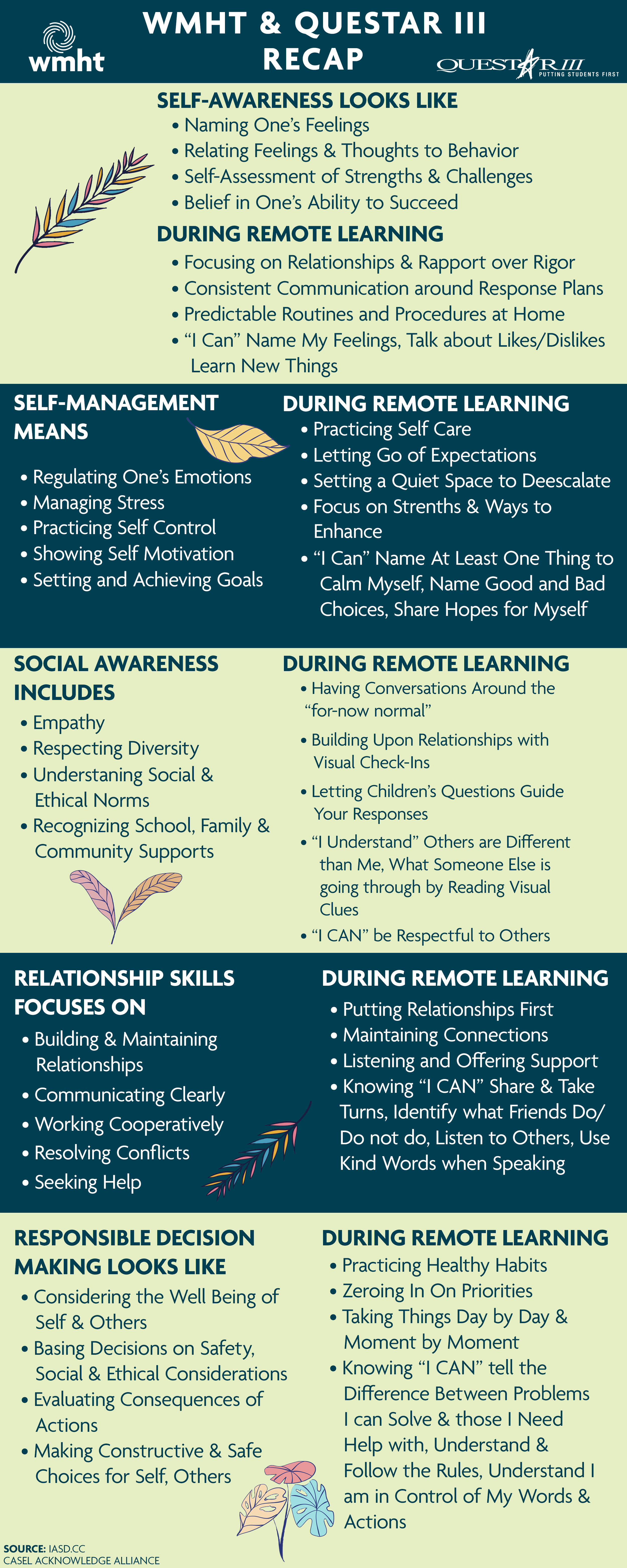Questar III BOCES shares tips for parents/caregivers and educators to support students with special needs during remote learning. Watch the videos and read below for helpful information and resources.
Remote Learning | Special Education: Educator Priorities and Parent/Caregiver Needs

Find value in pause
In response to the COVID-19 pandemic in New York State, Governor Cuomo has put the state on “pause.” Both children and adults are feeling a range of emotions with the scope and severity of the pandemic, the upending of routines and predictability to daily life and school closures. For students and families who receive critical services, the disruption is potentially compounded.
Given that children spend the majority of their time in school, educators are touchstones in their lives helping them shape and understand what is happening in their world and the greater community.
A response from school districts and teachers from a social emotional framework is found in taking a united pause and emphasizing relationships and rapport over rigor. Focusing first on relationships and emotional well-being, the gateway to continued learning opens. The points included below are the result of many conversations between WMHT and Questar III BOCES around the pandemic and remote learning impact on students, families, schools and special education teachers.
Social Emotional Learning
Social-emotional learning is a prevalent topic especially in the world of special education but perhaps more important than ever during COVID-19 school closures. The Collaborative for Academic, Social, and Emotional Learning (CASEL) defines social emotional learning (SEL) as “the process through which children and adults understand and manage emotions, set and achieve positive goals, feel and show empathy for others, establish and maintain positive relationships, and make responsible decisions.”
The CASEL framework for social emotional learning identifies five core competencies; Self-Awareness, Self-Management, Social Awareness, Relationship Skills and Responsible Decision Making.
Response Plans
The COVID-19 closures are particularly challenging for families of the 7.5 million special education students. Some students may fall into the category of “high risk” due to their health conditions. The different needs of students and families are to be taken into account when developing response plans and connecting to necessary resources. Checking-in with health-care providers as well as consistent communication between teachers, therapists, schools and caregivers is critical. Sensitivity, time, attention are needed in the collective response, creating a safe space for all parties to express needs and work closely to learn from one another and offer support.
Learning and Growth
With school-established routines disrupted parents and guardians can create new ones via a daily schedule. Creating consistent routines and procedures helps children feel more secure, understand what is expected of them, reduces stress and facilitates learning. Families can set up a quiet space for children to de-escalate, if needed. But, while setting schedules and expectations are important, showing flexibility in meeting needs is primary. Tasks, assignments and expectations should turn a focus on the child's strengths and look for creative ways to strengthen their abilities.
Self Care
Human connection is more important than ever. Moreover, it is important to remember that there is little precedent for the social isolation children are experiencing at this time. It is important to keep students engaged with their teachers and classmates. Missing out on this will take a toll on them. This is especially important for students without siblings. Younger children develop social skills and a sense of morality through play and other peer interactions. Be empathic and encourage children to talk about their feelings. Communication is key, children and adults need outlets and resources to handle stress and anxieties. Adults can seek out ways to build in mutual support and connection with colleagues, friends and fellow parents/ caregivers. Letting goof expectations is paramount and can usher in opportunities to connect and enjoy this time together.
When talking with a child about the pandemic, let their questions be your guide. Answer them truthfully, correct misinformation, keep explanations age appropriate and omit unnecessary details. Remind them that in the midst of every crisis we can always look to the helpers. And discover ways we are helpers too.
Support children or yourself during a challenging time by having a calm down checklist. Choose one of the following:
- Close eyes, Take deep breaths & count to five
- Ask for a sensory activity
- Ask for a break
- Ask to take a walk
- Ask for help
Supporting a Classroom Community Virtually
The pandemic has affected at least 55.1 million students in the United States. Schools need to keep it simple and zero in on key priorities, including manageable enrichment projects at home. The most important thing for parents/caregivers and educators to keep in mind is they cannot completely replicate the full classroom experience at home. Educators need to stay connected and engaged with their students and families – and with their colleagues and principals. The pandemic is bigger than all of us, take things day-by-day, if not moment by moment. Teachers, parents and caregivers can have conversations with students around routines that have developed in the “for-now normal.”
Maintaining Connections
Connections and student relationships are at the top of the priority list. Teachers are striving to maintain and build upon connections with their students even in the remote classroom. Visual check-ins are important. Students need to see teachers at this time, and vice versa. Teachers can pick up nonverbal cues that demonstrate whether a student is understanding an assignment or simply whether they are doing ok, students can ask a teacher a question, see a familiar and friendly face or seek additional help or guidance. Because of the relationships built from the first two thirds of the year, educators know students who struggle or may have unstable lives at home. These students are the ones who will be most impacted by the closures and transition to remote learning. Educators can make a special effort to reach out and connect with these students. After all, the ones who need the most help may be the ones least likely to reach out.
Teachers can play an influential role in helping students feel safe right now – even from a distance and “build in opportunities for students to reflect and contribute, pause to process their emotions and thoughts, connect and collaborate with their peers, and promote empathy”.
(Resources: https://casel.org/resources-covid/)




